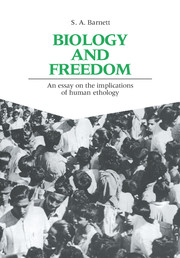Book contents
Part 2 - Homopugnax: the violent species
Published online by Cambridge University Press: 04 August 2010
Summary
See you now:
Your bait of falsehood take this carp of truth:
And thus do we of wisdom and of reach,
With windlasses and with assays of bias,
By indirections find directions out.
Shakespeare: HamletThe portrayal of human beings as inherently violent is supported by analogy. We, like other species, are a product of evolution, and are said to ‘inherit’ enmity from our animal ancestry. Social dominance among animals becomes social status in human communities, and the holding of territories by animals reappears as human ownership of property. These are represented as ‘instinctive’ or ‘innate’ and as involving destructive violence, or aggression.
Chapter 4 therefore compares the social lives of animals with those of human beings, and shows up the limitations of the idea of instinct. The argument from animals to humanity then breaks down at every important point: biological analysis cannot cope with either our intelligence or our social life.
Just as our violence has been said to reflect our animal ancestry, so ‘primitive man’ has been described as especially aggressive. In Chapter 5 we find that this belief is not based on authentic knowledge of our ‘Stone Age’ ancestors, or of any modern groups. People are often violent when they should be peaceful, and this is held out as natural; but, in that case, so are benignity, helpfulness, moderation and rationality. Violence is of many kinds, and cannot be reduced to a single impulse.
- Type
- Chapter
- Information
- Biology and FreedomAn Essay on the Implications of Human Ethology, pp. 29 - 32Publisher: Cambridge University PressPrint publication year: 1989



